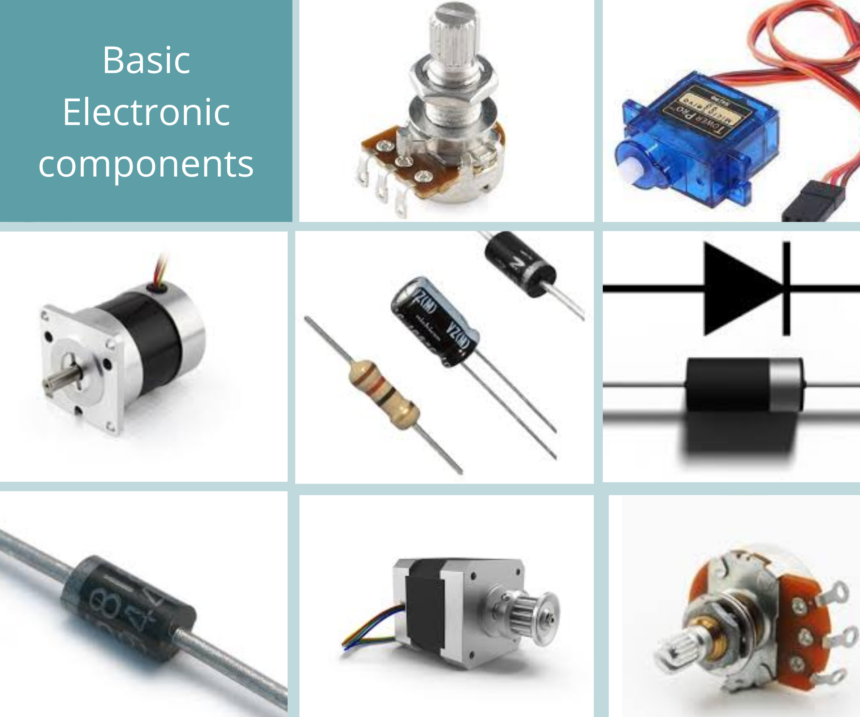Electronic devices surround and play a critical role in communication, computation, entertainment, and almost every other facet of modern life. Every electronics enthusiast—at both the hobby and professional levels—must understand the basic building blocks that go into these devices. In this article, you will learn about primary elements flowing in electronic devices, including their functions, types, and roles in circuits.
Types of Electronic Components
Most devices have small electronic circuits that control machines and process information. Electronic circuits are what keep most electrical appliances alive. You will learn about a detailed explanation of common electronic components used in these circuits and how they work. There are seven types of electronic components:
- Capacitor
- Resistor
- Diode
- Transistor
- Inductor
- Relay
- Quartz Crystal
Capacitor
A capacitor is a passive electronic element that stores electrical energy to then dispense it, if needed, in a circuit. The ability of the capacitor to store electric charge is called capacitance and is denoted by the symbol C. The unit of capacitance is the farad, F, and can range from microfarads, μF, 1×10-6 F, and nanofarads, nF, 1×10-9 F, to picofarads, pF, 1×10-12 F. Typical Capacitance Values: 1 pF to 1000 μF.
Applications of Capacitor
A capacitor is an electronic component that plays a big role in almost all circuits. It is a device that stores electrical energy and then provides it at times of need. Thus, it can be said that it is the basic need of energy storage in power supplies and for backup systems. Capacitors are used on the frontline of filtering applications, smoothing voltage fluctuations and ridding noise from the voltage to get stable and clear signals in audio equipment and communication devices.
They are largely applied for coupling and decoupling, letting through AC signals from one circuit stage to another and blocking undesirable DC components.
Also, capacitors are applied in timing circuits and those of oscillations, producing accurate time delays and generating particular frequencies. They also find applications in tuning circuits for radio devices and other frequency-dependent devices. In the case of motor starters, capacitors can provide the required phase shift at the startup.
They protect sensitive electronic components from voltage spikes by absorbing them and dissipating them safely to the ground and are also applied in capacitive sensors for detecting changes in their environment. Hence, in so many words, storing and managing electrical energy, the capacitor becomes an almost indispensable tool in a host of electronic applications.
Resistor
A resistor is a passive electrical component that gives protection from the progression of electric flow. It is utilized to control the flow in an electrical circuit by giving an exact measure of opposition (estimated in ohms). Resistors can be produced using different materials, including carbon, metal film, and wire-wound types. They are fundamental components in electronic circuits for capabilities like voltage division, biasing dynamic components, and restricting current. Resistors are described by their obstruction esteem, resilience, power rating, and temperature coefficient.
Diode
A diode is a semiconductor contraption that licenses current to stream in one course, with high deterrent the alternate way. It has two terminals: the anode and the cathode. The most notable kind of diode is the p-n convergence diode, which is outlined by joining p-type and n-type semiconductor materials. Right when the anode is more certain than the cathode, the diode is forward-uneven and leads current. At the point when the anode is more negative than the cathode, the diode is converse one-sided and obstructs current. Diodes are utilized in applications like amendment, signal demodulation, and security of circuits from voltage spikes.
Transistor
A transistor is a semiconductor device used to enhance or switch electronic signs and electrical power. It is made of semiconductor material with somewhere around three terminals for association with an outer circuit. The most broadly perceived kinds of semiconductors are bipolar crossing point semiconductors (BJTs) and field-influence semiconductors (FETs). In a BJT, the continuous stream between the finder and maker is obliged by the continuous stream between the base and producer. In a FET, the ongoing stream between the source and channel is constrained by the voltage applied to the entryway. Transistors are central structure blocks in current electronic devices, utilized in applications like enhancement, switching, and computerized rationale.
Inductor
An inductor is a passive electrical component that stores energy in an attractive field when electric flow moves through it. It regularly comprises of a curl of wire twisted around a center, which can be air or an attractive material. The inductance (estimated in henrys) relies upon the number of turns in the loop, the cross-sectional region of the curl, the length of the loop, and the center material. Inductors go against changes in current, making them helpful in applications, for example, separating, energy capacity in power supplies, and tuning circuits in radios.
Relay
A relay is an electrically worked change that utilizes an electromagnet to work a switching mechanism precisely. It permits a low-power sign to control a powerful circuit. A run-of-the-mill relay comprises of an info curl, an armature, a spring, and at least one arrangement of contacts. At the point when current moves through the curl, it creates an attractive field that draws in the armature, making the contacts open or close. Relays are utilized in different applications, including computerization frameworks, defensive relays in electrical grids, and as connection points between low-power control circuits and high-power devices.
Quartz Crystal
A quartz crystal is a piezoelectric material that can create an electrical sign with an exact recurrence when exposed to mechanical pressure. In hardware, quartz crystals are utilized as recurrence reference devices in oscillators and tickers because of their high strength and accuracy. While an exchanging voltage is applied to a quartz crystal, it vibrates at a, not entirely settled by the crystal’s cut and shape. Quartz crystals are broadly utilized in timekeeping devices, (for example, wristwatches and clocks), specialized devices, and different kinds of electronic gear to balance out frequencies and give exact timing.
These components are principal to the plan and activity of electronic circuits, each serving explicit capabilities that add to the general presentation and unwavering quality of electronic devices.


